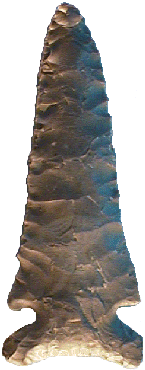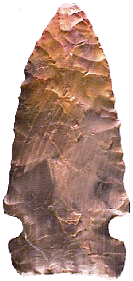



Point Type: OSCEOLA
Also See: Accokeek, Archaic Side
Notched, Big Sandy,
Black Sand Notched, Cache River, Cairo Side Notched, Godar, Graham Cave, Hemphill, Meadowood, Otter Creek, Oxbow, Raddatz
Location: Midwestern United States
Associated Dates:
4000 - 2500 B.P. - Late Archaic to Early Woodland
Morphology: Side-Notched
General Description: The Osceola type is a medium to large sized, narrow, side-notched point with parallel sided blade edges on longer examples, and trianguloid blade shapes on smaller specimens. The type also has a straight to concave base which may or may not be ground. The point is typified by extreme blade length when compared to other large side notched types. The Osceola exhibits large random percussion flake scars across the blade which are followed by finer marginal pressure retouch scars. Side notches are deep and are cut in from the side near the base and may be either squared, U-shaped or rounded in form. The basal ears are not pointed as in the Graham Cave type.
The Osceola was considered by Bell to be a large dart or spear point. Due to reworking of many specimens, it can be assumed that the blade also may have been used as a knife.
The Osceola point can range in size from 76 mm to 228 mm in length. The type was named by Robert Ritzenthaler in 1946 for points he recovered from Osceola site near Potosi, Wisconsin. The point is typically found in southern Wisconsin, Illinois, western Indiana, western Kentucky, northern Missouri, northern Tennessee and eastern Iowa although examples have been found further south and east.
About The Point Above (Left): The large Osceola point pictured at the top left of this page is 96 mm long, 36 mm wide at the basal ears, and is only 7 mm thick at mid blade just above the notches. The width across the barbs is 33 mm and the concavity of the base is 3.5 mm. The point is made from a grayish tanish flint that is patinated. The flint has slightly lighter tan veins which are just above the notches. The base and notches are ground. The basal ears are thinned to 4 mm. The base thickness at the concavity is 4 mm. The blade edges are quite sharp and show the thinning effects of reworking. I would estimate that the blade has been resharpened at least twice. The blade is from the former Johnnie Woodward collection and provenience information indicates that it was found near the town of Dickson, Dickson County, Tennessee. Catalog Number 238-115-D
About The Point Above (Right): The small Osceola point pictured at the top right of this page is 73 mm long, 33 mm wide at the barbs just above the notches, and is only 8 mm thick at mid blade just above the notches. The width across the basal tangs is 30.5 mm and the concavity of the base is 1.5 mm. The point is made from a colorful golden tanish flint that motled with darker colors (black and gray) and has bands of color running from the base to the tip. The base and notches are ground. The basal ears are thinned to 3 mm. The base thickness at the concavity is 4 mm. The blade edges are quite sharp and show the thinning effects of reworking. I would estimate that the blade may have been resharpened and perhaps was longer when new. However the fact that the barbs are wider than the basal edge leads me to believe that the blade has not undgone extensive rework other than perhaps to resharpen the tip. The blade is from the former Tim Veach collection and provenience information indicates that it was found in western Indiana. Catalog Number 106-31-R
References: Bell (1), Dragoo (c, e), Justice, Overstreet, Perino (1), Waldorf
© Copyright 1997 - 2008 LITHICS-Net WWW.LITHICSNET.COM
Use your Browser's BACK Button to return to the LITHICS-Net Index.